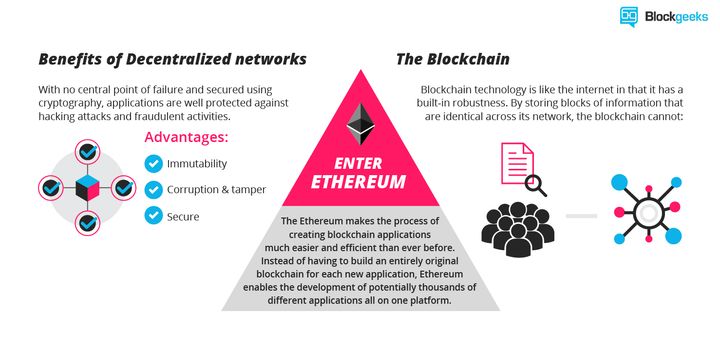The world has gone digital, from the development of smart homes to the development of innovations that promote seamless transactions. Every industry is feeling the impact of technology now more than ever. In every part of the world, the technologically driven goals remain the same: the maximization of profit and the promotion of sustainable development in all spheres of life. It is this yearning to make life as easy as possible that brought about the birth of cryptocurrency.
Ethereum seeks to make these aspirations come true. The platform boasts of several applications that help users carry out everyday tasks in a simple fashion.

Mining is a computationally intensive work that requires a lot of processing power and time. Mining is the act of participating in a given peer distributed cryptocurrency network in consensus. The miner is subsequently rewarded for providing solutions to challenging math problems. It is done by putting the computer's hardware to use with mining applications.
All the information on cryptocurrency transactions must be embedded in data blocks. Each block is linked internally to several other blocks. This creates the blockchain. These blocks must be analyzed as fast as possible to ensure a smooth running of transactions on the platform. However, the issuers of such currencies do not have the processing capabilities to handle this alone. It is where miners come in.
A miner is an investor that devotes time, computer space and energy to sorting through blocks. When the mining process hits the right harsh, they will submit their solutions to the issuer. After verification, the issuer of the currency offers rewards which are portions of the transactions they helped in verifying. They also offer digital coins in exchange for the work of miners. The result of digital mining is called proof of work system. Some currencies depend on this system alone while other use a combination of proof of stake and proof of work.
Mining is a word that originates from the gold analogy of the cryptocurrency sphere. It is not some get rich quick scheme. It requires time and effort to grow especially when you are working alone. The word was adopted because just as precious materials are difficult to see, so are digital currencies. Since mining must take place to increase the volume of precious metals in the market, digital mining must take place to increase the digital currencies in circulation.
The same thing applies to Ethereum. The only way to utilize Ethereum is with the product from mining. However, mining Ethereum means more than increasing the volume of Ether in circulation. It is also necessary for securing the Ethereum network as it creates, verifies, publishes, and propagates blocks in the blockchain.
Ethereum Mining is the process of mining Ether. Simply put, mining Ether equals securing the network which in turn ensures verified computation.
Ether is an absolute essential, as it serves as fuel for the smooth running of the Ethereum platform. An interesting way to look at Ether is an incentive used to motivate developers to create top notch applications.
Every developer seeking to engage and make use of smart contracts on the Ethereum blockchain needs Ether to proceed. It is popularly called the fuel that runs Ethereum. It is a less expensive way of running transactions on the network when compared to buying Ether. You can also decide to sell your Ether after mining.
Ether supply is not infinite. The overall amount of ether and the network operations was decided at the 2014 presale. No more than 18 million Ether gets issued every year, which is about 25 percent of the first issue. It serves as a system to reduce inflation.
Each block must have the proof of work of the given difficulty if it is to validated in consensus. The algorithm for validation is called Esthash. It has to do with identifying the nonce input to the result in such a way that it will be below a threshold that is determined by the difficulty. If the outputs are uniform in distribution, then the fact that the time required to find a nonce depends on the difficulty is guaranteed. In this case, simply manipulating the difficulty will allow a miner control how much time is required to find a new block.
In Ethereum Mining, the difficulty is adjusted dynamically so that the network produces one block in every 12 seconds on an average. Thanks to the synchronization of the system, it is not possible to rewrite history or maintain a fork except the individual attempting to do so has over half of the mining power in the network.
Ethereum Mining can be done in the comfort of your home. It requires script writing and some knowledge of the command prompt. It is quite easy and exciting once the process is broken down into manageable steps.
Before learning the steps, here are some basics you should keep in mind:
Mining Ether takes up a lot of electricity. On the plus side, though, if mining practices are carried out efficiently more income is generated through the sale of Ether. Ethereum mining calculators are available for calculating profits. So, there’s no need to get worked up since you’ll still get a profit at the end.
You can use any personal computer to mine Ethereum, provided the system has a Graphic Card (GPU) with at least 2 GB of RAM. Central Processing Unit (CPU) mining is simply an exercise in frustration. It takes an extended period to complete, and the profits are little thanks to the cost. GPUs are your best bet as they are 200 times faster than CPUs when it comes to mining Ether. AMD cards are more efficient than Nvidia cards as well.
Before following the provided steps, outlined below are some essential information you should keep in mind:
Mining Ether takes up a lot of electricity, and you are right in being concerned about this. On the plus side, though, if mining practices are carried out efficiently more income is generated through the sale of Ether. You will need your Ethereum Mining calculators for the process.
Ethereum Mining calculators are available for calculating profits. So, there’s no need to get worked up since you’ll still get a profit at the end.
It is imperative to have a lot of free space on your computer system’s hard drive. About 30 GB should be sufficient for the blockchain and other software.
Step One
You will need to Download Geth. This application will serve as a communication hub, linking you to the Ethereum platform while coordinating your setup (hardware and all) and reporting any new development that requires action on your part.
Step Two
Geth usually comes as a zip file, unzip and transfer the file to the HDD. The C: drive is usually best for this.
Step Three
You need the Command Prompt to execute the installed application. Search in Windows for ‘CMD,' if you are unsure about this, then click on it from the search list.
Step Four
‘C:\Users\Username>’ the username placeholder is the name of your computer and is the usual display format by the command terminal. Locating Geth is the next step; type in 'cd/' into the command prompt terminal; this is an instruction to change directory. ‘C:\>’ should be highlighted now, which means you are currently in the C: drive.
Step Five
Account creation comes next. To make a call to Geth; type in ‘geth account new' followed by the enter key. The command terminal should now display ‘C:\>geth account new.'
Step Six
A password will be of you at this stage, and extra care should be taken here. Be sure about your password, write it down if possible and be sure to type it in carefully. Press enter once again after typing in the password and voila! Your new account is created.
Step Seven
Geth needs to link up with the network before anything becomes fully operational. Type in ‘geth --rpc’ in the terminal and then press enter (you should be used to this by now), this action starts the download of Ethereum’s blockchain and synchronizing with the global network. This process is time intensive and is dependent on how large the blockchain is currently and the speed of your internet connection. Make sure you wait until the completion of this process before mining.
Step Eight
To proceed you need a mining software, which aids your GPU in running the hash algorithm required on the platform. Ethminer is a good choice for this heavy lifting.
Step Nine
Install Ethminer or any other mining software you choose for this procedure.
Step Ten
Repeat step 4 in a new command terminal (change directory command). To open a new command terminal, right-click on the previously active terminal icon found in the taskbar and then click on the terminal from the menu.
Step Eleven
In the new terminal window, type ‘cd prog’ followed by the tab key. ‘C:\>cd prog’ should now be on display, press the tab key again to display ‘C:/> cd "Program Files"' then push the enter key to show ‘C:\Program Files>.'
Step Twelve
To go into the Ethereum mining software folder, type ‘cd cpp' then the tab and enter keys. Press tab once again and the terminal should now display ‘C:\Program Files\cpp-ethereum>.'
Step Thirteen
To start mining with your GPU, key in ‘ethminer –G’ followed by the enter key. This will initiate the mining process after building the DAG ((Directed Acyclic Graph), which is a large file stored in the RAM of your GPU for the purpose of making it ASIC (Application Specific Integrated Circuits) resistant. Ensure that there is sufficient space on your hard drive before getting to this point.
Step Fourteen
Conversely, if you are up for it, CPU mining can be done. Just type in ‘ETHMINER’ then the enter key to start the process. The building of a DAG is still required in this step after which Geth takes over communication with Ethminer.
Currently, Ethereum uses the Proof of work (PoW) system- this has been the arm supporting blockchain technologies like bitcoin and Ethereum. Proof-of-work refers to the solving of complex equations, which is a basic requirement for a miner to clear for their block to be added to the blockchain. This system has been picked apart for the environmental damage and electric cost it generates. However, through the use of the Dagger Hashimoto algorithm, Ethereum created a way that permits simple home computers to mine efficiently with little expenditure necessary.
Additionally, Ethereum plans with its next update tagged Serenity, to take out the concept of mining entirely and replace it with a new mechanism called Proof of Stake which will be powered by a consensus algorithm.
The Ethereum network is a long string of connections maintained by computers, their impact is undeniable, and the profit gained from mined Ether is surreal. A lot of people are of the opinion that mining will stop with the advent of the consensus algorithm and advise those with itching curiosity to mine now and think later.
